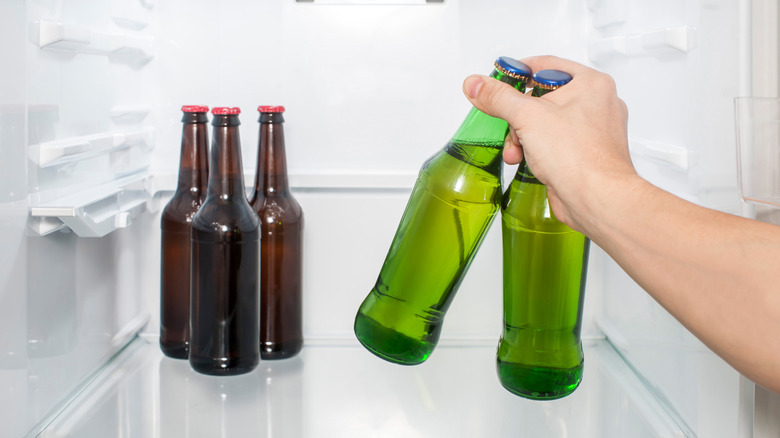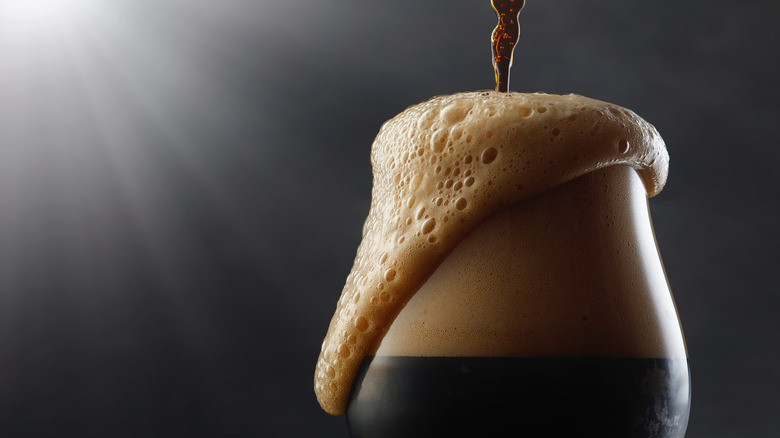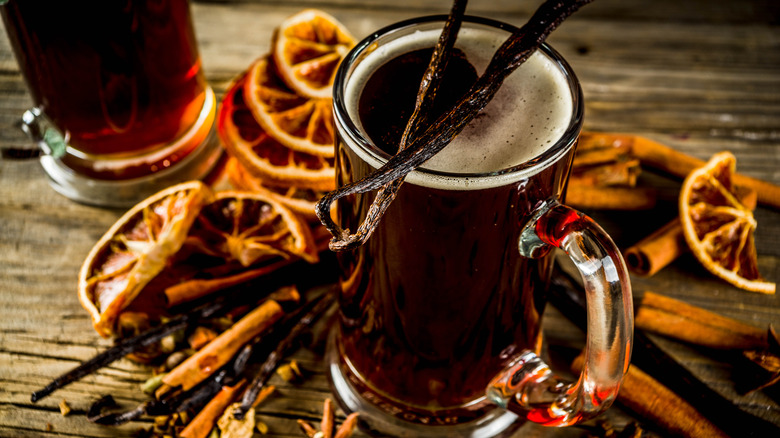It's A Myth That Beer Always Tastes Better Ice Cold
Whether outside on a hot summer afternoon, watching the big game, or winding down after a long day, it's hard to beat the crisp, refreshing taste of an ice-cold beer, right? Well, not necessarily. There are many myths about beer and the correct way to drink it, and one of these is the idea, popularized by adverts showing beers pouring into frost-chilled glasses in front of alpine backdrops, that beer is best when served cold. There's no denying that cold beer can be refreshing; tasting anything colder (or warmer) than our mouths generates more sensation because the nerves in your mouth are stimulated by temperature, as well as taste and touch. Drinking liquid sends signals to our brain that we're rehydrating, and cold liquids like beer create more stimulation, intensifying that refreshing sensation even more.
But refreshing isn't the same as better tasting. Cold temperature can enhance some characteristics of beer, such as bitterness, dryness, and carbonation, but these aren't necessarily pleasant; you'll know this if you've ever tried to down an ice-cold fizzy drink. Chilling to enhance these characteristics may sometimes be desirable, but many beers will taste disappointingly light on flavor, perhaps even watery, if too cold. In reality, the 'best' temperature to drink a beer can be a subjective one, with the answer depending on your culture, the type of beer you're drinking, and the kind of experience you're hoping to get from drinking it.
At what temperature should you drink beer?
Perhaps you're just after the refreshing sensation of a cold beer, plus the relaxing benefits of its alcohol content. That's perfectly okay, albeit in moderation, of course. However, if you're looking to savor a beer and take in its flavors and aromas, then you may want to think a little more about the temperature at which it's best to do so.
Higher temperatures cause the molecules in a substance to have more energy and therefore, move faster than they do when it's colder. Everyday examples of this are abundant, from the smell of fresh-baked bread outside a bakery to the stink of trash on a hot day. Concerning beer, warmer temperatures increase the diffusion of many flavor and aroma compounds, but some effects like carbonation will be reduced, and the flavors that are amplified are not always desirable either. Conversely, colder temperatures will have the opposite effect on your tastebuds, numbing them and reducing their ability to absorb — and your ability to perceive — flavor as effectively. Therefore, the best temperature to drink a beer depends on its type.
As a general rule, all beers should be served between 38 and 55 degrees Fahrenheit. Lagers and other light beers tend to be less complex, so they work better at cooler temperatures where their refreshing properties can be highlighted. On the other hand, it's recommended to serve more complex, darker, or stronger beers — stouts, porters, and real ales, for example — at the warmer end of the scale.
Cultural cases where beer isn't best served cold
Some countries have cultural reasons for serving beer at room temperature. In parts of Central Europe, specialist beers like the Belgian Glühkriek are best drunk hot, at around 160 degrees Fahrenheit. Mulled ale, traditionally made by plunging a hot metal rod into a pint of beer, has been enjoyed in Northern Europe for centuries. The practice even made its way to the U.S., before going out of fashion around the start of the 20th century with the rise of imported German lagers. Nonetheless, mulled ale is still made (albeit usually without using a metal warming rod) around the cold festive season in the United Kingdom and elsewhere, along with the more well-known mulled wine and mulled cider.
There are also plenty of cases of beer being drank warm, rather than hot. In some East African countries such as Kenya, it is not uncommon for beer to be enjoyed at room temperature, which is usually pretty warm. While the British enjoyed mulled beer more in previous centuries, serving cask ales and many stouts at cellar temperature (around 50 to 60 degrees Fahrenheit) is a common practice that continues today, with the notable exception of Guinness. There are also a few rare occasions when beer is meant to be drunk warm for a particular reason. One example is the classic American colonial-era flip cocktail, and a more recent — and unusual — concept is deep-fried beer bites, which contain warm stout.


